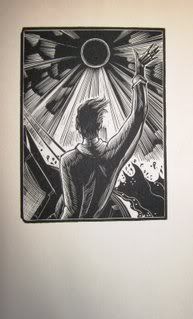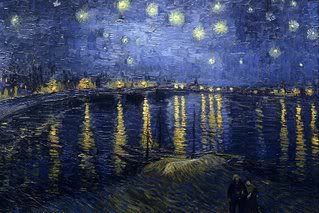
Last Thursday evening my husband and I headed to the Edmonton Art Gallery to take in the last of the Albrecht Durer exhibition. I'd been meaning to go for ages, but I'd never had the time.
This was my first visit to the Art Gallery of Alberta. I have to say I was rather disappointed. The exhibit itself was rather nice--the gallery had a large selection of Durer's prints, with some fairly good notes on the exhibition. But the overall atmosphere of the museum was lacking. Perhaps this was because the AGA is undergoing renovations, and the museum is currently being held in another location (the old Hudson's Bay Building in Downtown Edmonton).
The other thing that took me by surprise was the Museum's stand on photography. While taking a picture of one of the prints with my cellphone, I was informed by one of the museum's overzealous staff members that photography was not permitted in the museum. I had not seen the sign at the museum's entrance that said we couldn't take pictures, so I innocently reassured the fellow that there was no flash. It didn't matter, he informed me, visitors could not take photographs due to copyright reasons.
Now, being a blogger, I am fairly up to date on copyright issues. There cannot be any copyright on Durer's work--it's been nearly 500 years since his death! Nevertheless, one could hold copyright on Images of Durer's work, so the museum is apparently trying to ensure that they have the only images of the work and that public will have to pay for copies of their images--which is just silly, given the fact that there are numerous copies of Durer's work in the public domain (such as the one included in this post).
I honestly have never been to a museum that did not allow non-flash photography, so I was a little taken aback. Nearly every museum in Europe allows photography, so long as there is no flash used (which makes sense, right? Museums are supposed to protect art, not keep it from the public). I do realise that keeping the public from taking flash photography can be rather challenging. I have seen priceless works of art at the Louvre being snapped with full flash, and it always makes me cringe (especially since there are signs EVERYWHERE telling people not to take flash photos). As a result, I can understand why some museums might be tempted not to permit photography at all. Nevertheless, I believe it's important to allow photography. It's important that museums be exciting, open places--The AGA is more like a tomb where art goes to die.
But back to the art. The prints were spectacular. Both of us were amazed at the depth of Durer's prints, given the fact that he was born just twenty years after the advent of the printing press! Javier's favourite was Melencolia, simply because it had so much symbolism to dissect! It was fascinating.
I have a question for you all! One aspect of Melencolia wasn't explained in the gallery's exhibition notes. That was the grid in the upper right hand corner of the painting. It reminds me a little of Sudoku. The numbers all add up to 34 in every direction, but that's all I know! If anyone knows what it is, I would love to hear from you!
(image courtesy of Wikimedia)
Friday, October 17, 2008
Albrecht Durer Exhibit at the Edmonton Art Gallery
Posted by
Margaret
at
10:29 PM
12
comments
![]()
![]()
Saturday, October 11, 2008
The Pirates of Penzance
There is no better satire of Victorian life than the musicals of Gilbert and Sullivan. And while I enjoy all of Gilbert and Sullivan's musicals, I definitely have a soft spot for Pirates of Penzance.
I never get tired of watching the 1983 film adaptation of Pirates of Penzance, starring Kevin Kline. It tells the story of Frederick, an upstanding young man who happens to have spent his youth among pirates. On his 21st birthday, he announces that he is going to leave piracy behind and devote himself (albeit regrettably) to the "extermination" of his former friends. Once he falls in love with a girl, whose father is a Major General. Everything seems to be going well for Frederick until his former pirates friends show up and hilarity ensues.
In the end, the girls' father, General Stanley, proves himself a "model of a modern Major General" by accepting the pirates, who, after all, "with all their faults" still "love their Queen." It turns out that what they really crave is to settle down for a life of "unbounded domesticity." Of course, it doesn't hurt things when it turns out the pirates are actually peers of the realm. Being a rather dotty, social climbing member of the nouveau riche, the General immeadiately instructs the pirates to: "resume your ranks and legislative duties, and take my daughters, all of whom are beauties!"
There is no question that Kevin Kline steals the scene as the Pirate King. His sense of humor and ability is reminiscent of his peerless work in A Fish Called Wanda. His on-stage athletics are pretty impressive as well!
My sister and I watched this film more times than I could possibly count--50 at least. One of our favourite activities was attempting to sing "I am the very model of a modern Major General." Not an easy feat! The following scene includes both "Modern Major General" and the General's little song about being an orphan--which of course instantly melts the pirates' hearts (being orphans themselves, and good Englishmen at heart, they are doubtless well-schooled in the works of Dickens. It would be unthinkable to rob an orphan of his only company).
Posted by
Margaret
at
2:34 PM
13
comments
![]()
![]()
Wednesday, October 8, 2008
The Pre Raphaelites and Their World

I've really been missing the University library lately. I need to get an alumni membership, but I'm afraid I haven't gotten around to that yet. But as you can see from the picture above, I am starting my own collection of Pre-Raphaelite materials!
The other day my husband and I took a stroll near our home in Edmonton to enjoy the last of the lovely fall weather. He spied this beautiful book in a shop near Whyte Avenue and made me get it! We had been scouring the used book stores near our house for books on the Pre-Raphaelites. Generally I don't see much of anything, but this book was quite a find.
The Pre-Raphaelites and Their World is William Michael Rossetti's reminiscences about his brother and the rest of the members of the Pre-Raphaelites. For those of you who are familiar with William Holman Hunt's more gossipy version of the PRB's history, William Rossetti's account is something of an adjustment. His book is far less sensational, but as a historian, I think it's a great deal more reliable! Although William acknowledges that he cannot recall minute details about conversations that had taken 50 years before (unlike Holman Hunt, who transcribed full conversations), Rossetti fills the book with fabulous anecdotes that reveal a different, more thoughtful side of the Brotherhood. I would hugely recommend it to anyone who wants to learn more about the Pre-Raphaelites.
Of course, one of the main things that stood out to me immediately about this book was its beauty. It's a 1995 Folio edition of William Michael Rossetti's writing, and the whole volume is filled with lovely photographs (most by Margaret Cameron) and Pre-Raphaelite paintings. It's a truly lovely book and it's so nice to see a relatively new book that has been so beautifully made (it even came with a lovely little case to keep it looking pretty!). I don't think it's original owner had ever even opened it--I was really lucky!
So far, my favourite aspect of the book is William Michael Rossetti's recollection of his childhood. The Rossetti household must have been such an exciting place to grow up. No wonder that Christina and Dante Gabriel were such prolific writers and artists! Their home was really the ultimate in terms of a nurturing environment (and as I mentioned in an earlier post, this was really true of Millais' home as well). How lucky the Rossetti children were! They had the chance to actually converse with all of their father's artistic and literary friends from the time they were small children. I love William's story about four year old Dante Gabriel terrifying the milkman, who "saw a baby making a picture." Perhaps he was as much a prodigy as Millais, though it's hard to know.
Although this book doesn't offer theories about the Janey-Topsy-Rossetti love triangle, I appreciate its more subdued approach. There are so many books that dwell on the scandals of the Pre-Raphaelites that it is refreshing to be reminded of the exciting ideas, talents and aspirations that this group of people had.
Posted by
Margaret
at
6:25 PM
10
comments
![]()
![]()
Labels: books, pre-raphaelites, rossetti
Wednesday, October 1, 2008
4th Art History Carnival
Welcome to the October 1, 2008 edition of art history carnival.
art history
Jason presents 1599: Beatrice Cenci and her family, for parricide posted at Executed Today, saying, "The reciprocal social construction between a family tragedy, a Romantic legend, and a (misattributed) painting."
Stephen's blog, A World Away, examines illustrated books. I really enjoyed a recent post he did on Lynd Ward's 1929 Graphic Novel, God's Man. I really enjoyed looking at the illustrations. They're quite striking and very reminiscent of the advertising art from the period.

As you may or may not have noticed, my new job is certainly keeping me on my toes! I've been neglecting my little blogging paradise quite badly (for those of you who've asked, I've been working as a Legal Assistant--an interesting job, but a very fast-paced one). Nevertheless, while I've been neglecting my own blog, there have been lots of others who've been much more faithful than I! One of these is Sheramy, from Van Gogh's Chair. Sheramy, who is a Van Gogh scholar (I guess that doesn't exactly come as a surprise, now does it? She did a much better job of naming her blog than I did! Keywords, keywords), has been busy blogging away over the last few weeks. I particularly enjoyed her recent post on Van Gogh's "Other" Starry Night, "The Starry Night Over the Rhone."
 Isn't it lovely?
Isn't it lovely?Bob Aho created a lovely post that examines the Cathedral of Modena posted at Passing Gaz, it's a great article filled with photographs of the Cathedral and its fascinating relief sculptures. A must see/read!
That concludes this edition. Submit your blog article to the next edition of
art history carnival
using our carnival submission form.
Past posts and future hosts can be found on our blog carnival index page.
Technorati tags:
art history carnival, blog carnival.
Posted by
Margaret
at
6:28 PM
10
comments
![]()
![]()
Labels: blog carnival

